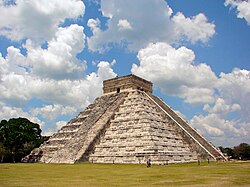 Chichen Itza (pronounced / tʃɛn i tʃi ː ː ː tsɑ /); [1] was an Maya civilization sites in Mexico in the 800 century BC. Pyramid of Kukulcan at this historic site complex believed to be the center of political and economic activities Mayan civilization located in the Yucatan Peninsula (Mexico area now). Merupkan Itza central point of the building complexes such as Kukulcan Pyramid, Temple of Chac Mool, and building Tiang Seribu
Chichen Itza (pronounced / tʃɛn i tʃi ː ː ː tsɑ /); [1] was an Maya civilization sites in Mexico in the 800 century BC. Pyramid of Kukulcan at this historic site complex believed to be the center of political and economic activities Mayan civilization located in the Yucatan Peninsula (Mexico area now). Merupkan Itza central point of the building complexes such as Kukulcan Pyramid, Temple of Chac Mool, and building Tiang Seribu Temple Chichen Itza is a Mayan archaeological heritage of the most complete and well preserved. Mayan civilization sites in Mexico was, on July 7, 2007, was selected as one of the seven wonders of the world's 100 million people a choice via email and sms (short message service) held by the Swiss Foundation.
According to the Mayan culture of the Chilam Balam, the temple complex was built between 502-522 AD. Mayan inhabitants only 200 years, then they move to the coast of Campeche. Yet another version says, Chichen Itza was built around 800 years BC.
Pyramid of Kukulcan at this historic site complex believed to be the center of political and economic activities Mayan civilization located in the Yucatan Peninsula (Mexico area now).
Itza is the central point of the building complexes such as Kukulcan Pyramid, Temple of Chac Mool, and building Tiang Seribu.
Chichen Itza in the temple there are two cenotes (natural wells) which is used as a place to put a sacrifice. It is said that Maya Indians who inhabited the city was offering jade, ceramics, and even humans to be included in the well. Offerings were given when the drought struck. Sometimes offerings of young girls to be put alive into the well. Role of the well is so important because there is no Yukatan Peninsula rivers. The only source of water when the drought hit is from the wells.
The name Chichen Itza means any water on the lips of the people's eyes in the local Indian language. Thus, Chichen Itza developed into the economic center of government and Mayan culture.
It is said, Chichen Itza is a symbol of worship and science. Chichen Itza was founded Toltec king named Quetzalcoatl tribe who came to the Peninsula Yukatan with his troops. At that time the Maya had settled in the area, then together Toltec tribes, began to build the pyramid-like temples. Thus, the peak period of Chichen Itza is a mixture of Toltec and Maya cultures.
One of the largest temple was erected Kukulkan. Based on Mayan legend, the god Kukulkan is a snake-haired incarnation of Quetzalcoatl. Temple of Kukulkan pyramid bertangga, with terraces. On each side of a square pyramid, there are steps to the summit. At the top there is the entrance to the room Crown King Jaguar Stone Kukulkan, which was painted red and green spots of moss.
At Chichen Itza there is also a field game similar to a basketball game today. Games 'pok ta pok' throw the ball through a circle on the wall 7 feet above the ground. The captain of the team who first succeeded in shooting the ball would cut off his head as an offering to the gods.
In the year 1221, a rebellion broke out. Wooden roofs, markets and temples burned knight. Yukatan power over any move to Mayapan, until the Spanish conquerors arrived.
This temple complex is extensive and each temple separated from each other with others. In the middle stands the temple of El Castilo (Palace) of complete renovation. Pyramid shape, the roof just dull. Seeing the temple El reminiscent Castilo Sukuh temple in Karanganyar, Solo. Both this temple as the temple of El kembar.Keistimewaan brother Castilo are the steps to the temple. Any date 21Maret and 23 September between day and night equal length. At that time during the day, the temple steps shadows. So that our eyes deceived, as if there were a lot of snakes up the temple. But the next day at the same time will seem as if the snake came down the steps.
Around the temple complex there is a statue called the Red Jaguars. According to Bishop Landa, in this place are often held ceremonies. Victim of a panther (Jaguar), turtles, turkeys, dogs or any animal heart. Even sometimes the victims are men.
Around the temple complex found in all eight Chac Mool statue. Human-shaped statues sitting up position. Both holding tanggannya offerings and head turned to the left. Chac Mool to worship the god of rain.
Still in the Chichen Itza complex, there are two walls of equal height. Arena between the two walls that the Maya used to play ball. It is possible that the ball made of rubber, considering that the area around the rubber trees grow. Not only the Maya who likes to play ball, but also ethnic Zapotec
Rate Us

0 comments:
Post a Comment